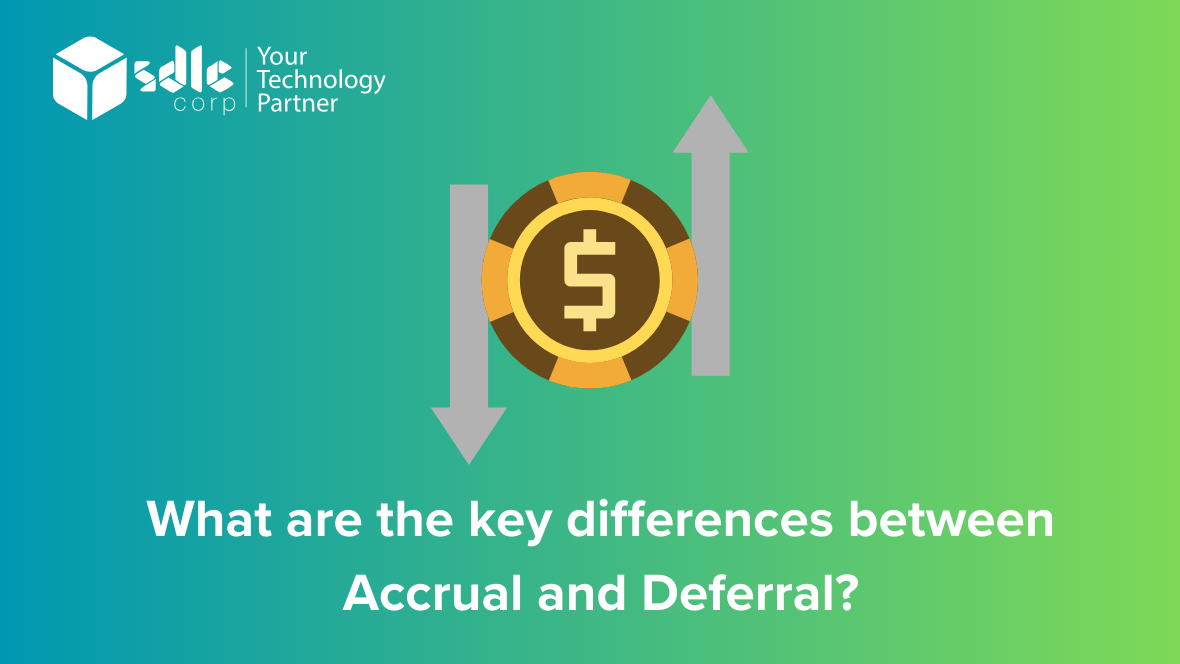What Are the Key Differences Between Accrual and Deferral?
Accrual accounting and deferral accounting are two fundamental methods used in financial reporting, each with distinct implications for recognizing revenue and expenses. Accrual accounting records revenue and expenses when they are earned or incurred, irrespective of cash movements. This ensures that financial statements accurately reflect the financial performance and position of a business over a specific period, adhering to the matching principle. For instance, accrued revenue encompasses services provided but not yet invoiced, while accrued expenses include costs incurred but not yet paid, like utilities or wages. In contrast, deferral accounting involves postponing the recognition of revenue or expenses until a later accounting period, even if cash transactions occur earlier. Deferred revenue, or unearned revenue, represents cash received in advance for goods or services not yet delivered, while prepaid expenses, such as insurance or rent, are recorded as assets until they are incurred. Both accruals and deferrals play crucial roles in providing a comprehensive picture of a company’s financial status and performance. Alongside these accounting principles, accounts payable, representing outstanding obligations to suppliers for goods or services purchased on credit, constitute a significant aspect of financial management. Understanding accounts payable is essential for managing cash flow effectively, maintaining vendor relationships, and ensuring timely payments to uphold favorable credit terms.
How Its Work?
Accrual and deferral are accounting concepts used to recognize revenue and expenses in a company’s financial statements. Let’s break down each concept and then address the frequently asked questions (FAQs) about them:
Accrual:
Accrual accounting recognizes revenue and expenses when they are earned or incurred, regardless of when cash is exchanged. This means revenue is recognized when it is earned, and expenses are recognized when they are incurred, even if cash transactions haven’t occurred yet. Accrual accounting provides a more accurate representation of a company’s financial position by matching revenues and expenses to the period in which they are incurred, rather than when cash changes hands.
Deferral:
Deferral accounting, on the other hand, postpones the recognition of revenue or expenses to a later accounting period. This is done when cash is received or paid in advance of when revenue is earned or expenses are incurred. Deferral accounting often involves recording prepaid expenses or unearned revenue on the balance sheet until they are earned or used, at which point they are recognized on the income statement.
Key Differences:
- Timing of Recognition: Accrual accounting recognizes revenue and expenses when they are earned or incurred, while deferral accounting postpones recognition to a later period.
- Cash Flow vs. Accrual: Accrual accounting focuses on matching revenues and expenses to the period in which they are earned or incurred, regardless of cash flow. Deferral accounting involves recording cash receipts or payments in advance of revenue recognition or expense incurrence.
- Financial Statement Impact: Accrual accounting provides a more accurate depiction of a company’s financial performance and position by matching revenues and expenses to the period in which they occur. Deferral accounting can result in differences between cash flow and reported income due to the postponement of revenue or expense recognition.
How Does a Receipt Scanner Relate to Accrual and Deferral Accounting?
A receipt scanner can streamline the process of recording expenses, which is essential for both accrual and deferral accounting. By digitizing receipts and automatically categorizing expenses, a receipt scanner can ensure that expenses are accurately recorded in the appropriate accounting period, aligning with the principles of accrual accounting. Additionally, for deferral accounting, a receipt scanner can help track prepaid expenses or unearned revenue by capturing receipts for advance payments and integrating them into the accounting system to facilitate proper recognition when the revenue is earned or the expenses are incurred.
In summary, while accrual and deferral accounting focus on the timing of revenue and expense recognition, a receipt scanner can aid in the accurate recording and management of expenses, supporting the principles of both accounting methods.
What is Accrual Accounting?

Accrual accounting is a method of accounting that records revenues and expenses when they are earned or incurred, regardless of when the cash is actually exchanged. In other words, it recognizes economic events when they occur, rather than when cash transactions take place. This approach provides a more accurate depiction of a company’s financial performance and position compared to cash basis accounting, which records transactions only when cash is received or paid.
In accrual accounting, revenues are recorded when they are earned, meaning when the goods are delivered or services are performed, regardless of when payment is received. Similarly, expenses are recorded when they are incurred, such as when goods or services are received, regardless of when payment is made. This method ensures that income and expenses are matched in the period to which they relate, providing a more realistic view of a company’s profitability and financial health.
Accrual accounting is especially important for businesses that extend credit to customers or receive credit from suppliers, as it allows them to accurately track their financial transactions and performance over time. By recording revenues and expenses as they occur, accrual accounting provides a clearer picture of a company’s financial position, enabling better decision-making by management and stakeholders.
These scanners have become increasingly popular due to their convenience and versatility. They are used in various industries and applications, including marketing, advertising, retail, logistics, and ticketing. QR codes can be printed on packaging, advertisements, business cards, tickets, and more, allowing users to access relevant information quickly and easily by scanning the code with their smartphones or other devices.
QR code scanners are available as standalone apps for smartphones and tablets, as well as integrated features in many mobile devices’ cameras. They have simplified many tasks and transactions, allowing users to access information, make purchases, and interact with businesses and organizations seamlessly.
Unveil Financial Insights: Explore Accrual vs. Deferral Today!

What is Deferral Accounting?
Deferral accounting is a fundamental concept in accounting that deals with the recognition of revenues and expenses at the appropriate time, rather than when cash is received or paid. It involves postponing the recognition of certain transactions until a later period to match revenues with expenses accurately.
Here’s a detailed breakdown of deferral accounting:
1. Timing of Recognition: In deferral accounting, revenues and expenses are recognized in the period in which they are earned or incurred, rather than when cash is exchanged. This ensures that financial statements reflect the true economic performance of a business during a specific accounting period.
2. Types of Deferrals:
- Deferred Revenue: Also known as unearned revenue, this occurs when a company receives payment from a customer for goods or services that have not yet been provided. The revenue is recognized as it is earned over time or upon delivery of the goods or services.
- Deferred Expenses: Also called prepaid expenses, this involves the payment of cash for expenses that will benefit the business in future accounting periods. These expenses are initially recorded as assets and then expensed over the periods in which they provide benefits.
3. Recognition Methods:
- Straight-Line Method: This method evenly distributes the recognition of revenue or expenses over the periods benefited. For example, if a company receives $12,000 for a one-year service contract, it would recognize $1,000 of revenue each month.
- Accelerated Method: Some deferrals, such as depreciation expenses, may be recognized more heavily in the early periods and less in later periods to reflect the diminishing value of an asset over time.
4. Journal Entries: The initial receipt of cash for deferred revenues or payment of cash for deferred expenses is recorded with a journal entry that debits cash and credits the corresponding liability (for deferred revenue) or asset account (for deferred expenses). As revenue is earned or expenses are incurred, adjusting entries are made to recognize the portion that belongs to the current accounting period.
5. Financial Statement Impact:
- Income Statement: Deferral accounting affects the income statement by matching revenues with the expenses incurred to generate them, resulting in a more accurate representation of profitability.
- Balance Sheet: Deferred revenues and expenses impact the balance sheet by affecting asset and liability accounts until they are recognized as revenue or expense.
- Cash Flow Statement: Deferral accounting does not directly impact cash flow, as cash transactions are recorded when they occur, but it does affect the timing of revenue and expense recognition.
6. Examples:
- Deferred Revenue: Subscription services, advance payments for goods or services, annual maintenance contracts.
- Deferred Expenses: Prepaid insurance, prepaid rent, prepaid advertising.
Overall, deferral accounting plays a crucial role in ensuring that financial statements provide a true and fair view of a company’s financial performance and position by recognizing revenues and expenses in the periods in which they are earned or incurred.
What Are the Variances Between Accrual and Deferral Accounting Methods?

Accrual and deferral accounting are two primary methods used in financial accounting to recognize revenue and expenses. Here’s a detailed comparison of the variances between the two:
1. Timing of Recognition:
- Accrual Accounting: Revenue and expenses are recognized when they are incurred, regardless of when the cash transaction occurs. This means revenue is recognized when it is earned, and expenses are recognized when they are incurred, even if the cash transaction hasn’t taken place yet.
- Deferral Accounting: Revenue and expenses are recognized only when the cash transaction occurs. This means revenue is recognized when cash is received, and expenses are recognized when cash is paid out.
2. Revenue Recognition:
- Accrual Accounting: Revenue is recognized when it is earned, typically when goods or services are delivered to the customer, irrespective of when the cash is received.
- Deferral Accounting: Revenue is recognized only when cash is received, meaning it’s recorded on the income statement when the payment is actually made.
3. Expense Recognition:
- Accrual Accounting: Expenses are recognized when they are incurred, meaning when goods or services are received, regardless of when the cash payment is made.
- Deferral Accounting: Expenses are recognized only when cash is paid out, meaning they’re recorded on the income statement when the payment is made.
4. Matching Principle:
- Accrual Accounting: Adheres more closely to the matching principle, which aims to match revenues with expenses in the period in which they are incurred, providing a more accurate representation of the financial performance of a business.
- Deferral Accounting: May not always adhere strictly to the matching principle, as revenue and expenses are recognized only when cash transactions occur, which may not align with when the related revenue is earned or expenses are incurred.
5. Complexity:
- Accrual Accounting: Generally considered more complex because it requires tracking revenue and expenses when they are incurred, regardless of cash movements.
- Deferral Accounting: Can be simpler in some cases because it aligns more closely with cash movements, making it easier to understand for some businesses.
6. Financial Statement Impact:
- Accrual Accounting: Provides a more accurate representation of a company’s financial position and performance since it recognizes revenue and expenses when they occur, providing a clearer picture of profitability.
- Deferral Accounting: May result in distortions in financial statements, especially in periods with significant cash flows but mismatched revenue and expenses.
7. Regulatory Compliance:
- Accrual Accounting: Generally required for publicly traded companies and mandated by accounting standards such as Generally Accepted Accounting Principles (GAAP) and International Financial Reporting Standards (IFRS).
- Deferral Accounting: Can be used by smaller businesses or for tax reporting purposes, but may not always comply with GAAP or IFRS.
In summary, while both accrual and deferral accounting methods aim to track financial transactions, they differ primarily in when revenue and expenses are recognized. Accrual accounting provides a more accurate representation of a company’s financial performance over a period, while deferral accounting may be simpler but can lead to distortions in financial statements. The choice between the two methods depends on factors such as regulatory requirements, business size, and the need for accuracy in financial reporting.
Why Are Timing Differences Important in Accounting?
Timing differences play a crucial role in accounting due to their significant impact on financial reporting accuracy, tax liabilities, and managerial decision-making. Here’s a detailed breakdown:
1. Financial Reporting Accuracy: Timing differences refer to variations in when transactions are recognized for accounting purposes versus when they are recognized for tax purposes. These differences can arise due to various factors such as revenue recognition policies, depreciation methods, and inventory valuation techniques. Ensuring alignment between financial reporting and tax reporting is essential for accurately portraying the financial health and performance of a company to stakeholders, including investors, creditors, and regulatory bodies.
2. Tax Implications: Timing differences directly affect tax liabilities. In some cases, recognizing revenue or expenses earlier for tax purposes can lead to tax savings, while in other cases, it may result in higher tax liabilities. Understanding and properly managing timing differences enable companies to optimize their tax planning strategies, minimize tax liabilities, and ensure compliance with tax regulations.
3. Managerial Decision-Making: Timely and accurate financial information is critical for effective managerial decision-making. Accounting for timing differences allows managers to assess the true profitability and financial position of the company, enabling them to make informed decisions regarding resource allocation, investment opportunities, and strategic planning. Misjudging the timing of revenue or expenses could lead to erroneous decisions that may adversely impact the company’s performance and competitiveness.
4. Cash Flow Management: Recognizing timing differences helps in managing cash flows efficiently. For example, understanding when tax obligations arise allows businesses to plan their cash outflows accordingly, avoiding liquidity issues and potential penalties for late payments. Similarly, identifying discrepancies between cash flow and reported earnings helps in evaluating the company’s ability to generate cash and meet its financial obligations.
5. Audit and Compliance: Accurate accounting for timing differences is essential for audit purposes and ensures compliance with accounting standards and regulations. Auditors examine the company’s financial statements to verify that transactions are recorded in the appropriate periods and in accordance with relevant accounting principles. Failure to address timing differences adequately can raise red flags during audits and may result in financial restatements or regulatory penalties.
In addition to the aforementioned points, the emergence of digital payment platforms like PayPal has introduced new considerations regarding timing differences in accounting. For instance, when a company receives funds through a PayPal wire transfer, there may be a delay between the transaction date and the actual availability of funds in the company’s bank account. Accounting for such timing differences accurately is essential for maintaining the integrity of financial records and ensuring compliance with accounting standards.
Dive into Accounting: Understand Accrual vs. Deferral Now!

What Are the Main Differences Between Accrual and Deferral Methods in Finance?
Sure, let’s delve into the main differences between accrual and deferral methods in finance:
Accrual Method:
- Recognition of Revenue and Expenses: The accrual method recognizes revenue and expenses when they are incurred, regardless of when cash is actually exchanged. This means revenue is recorded when it is earned, and expenses are recorded when they are incurred, even if payment hasn’t been received or made.
- Matching Principle: It follows the matching principle, which aims to match revenues with expenses in the period in which they are incurred. This helps in providing a more accurate picture of a company’s financial performance during a specific period.
- Timing: Transactions are recorded as they occur, which means that revenues and expenses are reflected in financial statements for the period in which they are earned or incurred, not necessarily when cash is received or paid out.
- Accurate Representation: Provides a more accurate representation of a company’s financial position and performance since it reflects all economic activities that have taken place during a period, regardless of when cash transactions occur.
- Complexity: It can be more complex than the cash basis method because it requires adjustments for accrued revenues and expenses.
Deferral Method:
- Recognition of Revenue and Expenses: The deferral method involves recognizing revenue and expenses when cash is actually received or paid out, rather than when they are incurred. This means revenue is recorded when it is received, and expenses are recorded when they are paid, regardless of when the underlying economic activity occurs.
- Timing: Transactions are recorded only when cash is exchanged, meaning revenues and expenses are not necessarily recognized in the period in which they are earned or incurred.
- Simplicity: The deferral method can be simpler to implement and understand compared to the accrual method because it does not require adjustments for accrued revenues and expenses.
- Limited Insight: It may provide a less accurate representation of a company’s financial position and performance since it may not reflect all economic activities that have taken place during a period.
- Cash Flow Focus: This method is more focused on cash flow, as it reflects the actual inflow and outflow of cash rather than the underlying economic activity.
Key Differences:
- Timing of Recognition: The primary difference between the two methods lies in the timing of when revenues and expenses are recognized. Accrual accounting recognizes them when they are incurred, while deferral accounting recognizes them when cash is exchanged.
- Matching Principle vs. Cash Basis: Accrual accounting adheres to the matching principle, while deferral accounting follows a cash basis approach.
- Accuracy vs. Simplicity: Accrual accounting generally provides a more accurate picture of a company’s financial position and performance, but it’s more complex to implement compared to deferral accounting, which is simpler but may offer less insight into financial activities.
In summary, while both methods serve their purpose, the choice between accrual and deferral accounting depends on factors such as the nature of the business, regulatory requirements, and the need for accuracy versus simplicity in financial reporting.
What is the Significance of Accrual Versus Deferral in Financial Planning?

Accrual versus deferral in financial planning are two fundamental concepts that deal with the timing of recognizing revenue and expenses in financial statements. Let’s break down each concept and discuss their significance in financial planning:
Accrual: Accrual accounting recognizes revenue and expenses when they are earned or incurred, regardless of when cash is exchanged. This means that revenue is recorded when it’s earned, and expenses are recorded when they are incurred, even if the cash transaction hasn’t occurred yet.
Significance in Financial Planning:
- Accuracy: Accrual accounting provides a more accurate representation of a company’s financial health by matching revenues with the expenses incurred to generate them. This gives stakeholders a clearer picture of the company’s profitability over a given period.
- Transparency: Accrual accounting offers greater transparency by showing the true financial position of a business, as it reflects all economic events that have occurred, regardless of when cash transactions take place.
- Better Decision Making: With accrual accounting, financial planners can make more informed decisions based on the current financial status of the company, as it reflects the economic reality rather than just cash movements.
- Compliance: Many regulatory bodies and accounting standards, such as Generally Accepted Accounting Principles (GAAP) and International Financial Reporting Standards (IFRS), require businesses to use accrual accounting for financial reporting purposes.
Deferral: Deferral accounting, on the other hand, delays the recognition of revenue or expenses until cash is exchanged. This means that revenue is recorded when cash is received, and expenses are recorded when cash is paid, regardless of when the economic activity occurred.
Significance in Financial Planning:
- Simplicity: Deferral accounting can be simpler and easier to understand for small businesses or individuals who may not have complex financial transactions. It tracks cash flows directly, making it easier to reconcile with bank statements.
- Cash Management: Deferral accounting helps in managing cash flows more effectively, as it focuses on actual cash movements. This can be crucial for businesses with limited liquidity or those operating in volatile markets.
- Tax Planning: Deferral accounting can sometimes offer tax advantages, as it allows businesses to defer recognizing income until a later date, potentially reducing current tax liabilities.
- Predictability: Deferral accounting provides a clear understanding of cash inflows and outflows, making it easier to predict future cash needs and plan accordingly.
In summary, while accrual accounting provides a more accurate depiction of a company’s financial performance, deferral accounting offers simplicity and focuses on actual cash movements. The choice between accrual and deferral depends on various factors such as the size of the business, its industry, regulatory requirements, and the preferences of stakeholders. Financial planners need to carefully consider these factors to choose the most suitable accounting method for their specific situation.

What Are the Benefits of Accrual Versus Deferral?
Certainly! Let’s break down the benefits of accrual versus deferral accounting methods:
Accrual Accounting:
- Matching Principle: Accrual accounting matches revenues with expenses, regardless of when cash exchanges hands. This provides a more accurate representation of a company’s financial health by reflecting income earned and expenses incurred during a specific period.
- Timely Recognition: Accrual accounting recognizes revenue when it’s earned and expenses when they’re incurred, providing a more accurate picture of a company’s financial performance in real-time. This helps in making informed business decisions and assessing the company’s profitability accurately.
- Better Measurement of Performance: Accrual accounting provides a more comprehensive view of a company’s financial performance by capturing all economic activities, even if cash transactions haven’t occurred yet. This allows stakeholders to assess the company’s performance more accurately and make informed decisions about its future.
- GAAP and IFRS Compliance: Accrual accounting is in compliance with Generally Accepted Accounting Principles (GAAP) and International Financial Reporting Standards (IFRS), making financial statements more comparable and reliable across different entities and industries.
- More Transparent Financial Statements: Accrual accounting provides transparency by disclosing accrued revenues and expenses in financial statements, giving stakeholders a clear understanding of the company’s financial position and performance.
Deferral Accounting:
- Cash Flow Management: Deferral accounting helps in managing cash flow by deferring the recognition of certain revenues or expenses until a later period. This allows companies to match cash inflows with cash outflows more effectively and maintain liquidity.
- Tax Planning: Deferral accounting can be beneficial for tax planning purposes as it allows companies to defer recognizing income until a later period, thereby delaying tax payments and potentially reducing current tax liabilities. Similarly, deferring certain expenses can help in maximizing deductions and reducing taxable income.
- Simplicity: Deferral accounting may be simpler to implement and understand for small businesses or those with straightforward revenue and expense streams. By deferring the recognition of certain transactions, businesses can streamline their accounting processes and reduce complexity.
- Regulatory Compliance: In some cases, deferral accounting may be required or preferred for regulatory compliance or industry-specific reporting standards. By deferring the recognition of certain transactions, companies can ensure compliance with relevant regulations and reporting requirements.
- Smoothed Income Recognition: Deferral accounting can help in smoothing out income recognition over multiple periods, which can be beneficial for industries with irregular revenue streams or seasonal fluctuations. This can provide a more stable and predictable financial picture, which may be desirable for investors and stakeholders.
Both accrual and deferral accounting methods have their own set of benefits, and the choice between them depends on various factors such as the nature of the business, regulatory requirements, financial objectives, and reporting standards.
Conclusion
Accrual and deferral are two fundamental accounting concepts with key differences in how they recognize revenues and expenses on financial statements. Accrual accounting records revenues and expenses when they are earned or incurred, regardless of when cash transactions occur. This means revenue is recognized when it’s earned, and expenses are recorded when they’re incurred, even if cash hasn’t exchanged hands yet. For instance, a company might recognize revenue for services rendered in December, even if payment isn’t received until January. In contrast, deferral accounting postpones the recognition of revenue or expenses until a later accounting period, typically when cash is received or paid. This occurs when revenue hasn’t been earned or expenses haven’t been incurred at the time of the cash transaction. For example, if a company receives payment in advance for services to be provided in the future, the revenue is deferred until those services are performed. These distinctions affect how businesses report their financial activities, with accrual accounting providing a more accurate reflection of a company’s financial position and performance over a period, while deferral accounting helps match revenues and expenses with the periods they relate to, ensuring accurate financial reporting.
FAQs
1. What is accrual accounting?
Accrual accounting recognizes revenue and expenses when they are incurred, regardless of when cash is exchanged. This means revenue is recorded when it’s earned, and expenses are recorded when they’re owed, rather than when payment is made.
2. What is deferral accounting?
Deferral accounting, on the other hand, delays the recognition of revenue or expenses until cash is exchanged. Revenue is recorded when payment is received, and expenses are recorded when they’re paid, regardless of when the transaction actually occurred.
3. How do accrual and deferral differ in timing of recognition?
Accrual accounting recognizes revenue and expenses as they are earned or incurred, regardless of cash flow timing. Deferral accounting, however, defers recognition until cash changes hands, either by delaying revenue recognition until payment is received or by postponing expense recognition until payment is made.
4. What are the main advantages of accrual accounting?
Accrual accounting provides a more accurate depiction of a company’s financial health and performance over a specific period, as it reflects economic reality by matching revenues with expenses incurred during the same period. This method offers a more comprehensive view for stakeholders, aiding in better decision-making.
5. When would a company use accrual versus deferral accounting?
Companies typically use accrual accounting when they want to accurately represent their financial performance over a period, especially when revenues and expenses don’t align with cash flows. Deferral accounting may be preferred when companies want to simplify accounting processes or when cash flow is a critical consideration, such as for tax purposes or in cash-strapped situations.
Contact Us
Let's Talk About Your Project
- Free Consultation
- 24/7 Experts Support
- On-Time Delivery
- sales@sdlccorp.com
- +1(510-630-6507)















